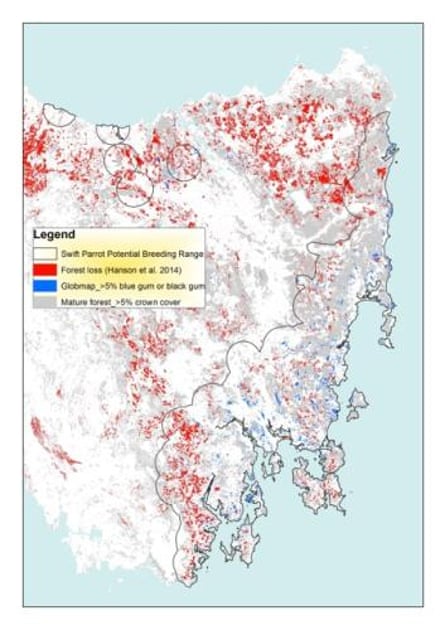The Tasmanian government ignored the advice of its own experts to push ahead with logging in the habitat of the endangered swift parrot, internal departmental documents have revealed.
The documents show that experts warned the Tasmanian Department of Primary Industries, Parks, Water and the Environment of the impact of approving logging in five areas of forest in the state’s south-east.
In one area, called a logging coupe, the advice states that the felling of trees will “result in the continued loss of breeding habitat that has been identified as being of very high importance for the species with the further fragmentation of foraging habitat. This cannot contribute to the long-term survival of the species.”
The advice adds that the area earmarked for logging is “within close proximity to known nesting sites for the species.”
It warns that any logging is “likely to interfere with the recovery objectives for the species as outlined above. There is no scientific evidence to support the position that continued harvesting of breeding habitat will support conservation objectives for the species.”
The advice states that further loss of habitat would not meet the government’s objectives of “ecologically sustainable forest management” in its forestry policies and planning guidelines.
This advice is repeated for other logging coupes, as well as a proposal to clear 12 hectares of forest on private land for an “eco-tourism development.”
Conservation group Environment Tasmania obtained the documents, which cover a 12-month period to July 2014, under freedom of information. It said that despite the expert advice obtained by the department, logging was approved for at least three of the five coupes in question. The three coupes were approved for logging by the Liberal government shortly after it won the March 2014 state election.
The logging areas are all within the southern forests area of Tasmania, a region that provides crucial breeding habitat for the endangered swift parrot.
The small, colourful parrot, which weighs just 65g, conducts the longest known annual migration of any parrot in the world, largely to Victoria and New South Wales. However, it only breeds in the southern and eastern parts of Tasmania, carefully selecting flowering blue gum and black gum trees with hollows for nests.

The swift parrot is listed as endangered nationally and internationally. It’s thought just 2,000 to 2,500 remain, although counting them is a difficult exercise.
Phill Pullinger, a spokesman for Environment Tasmania, said the state and federal governments needed to halt the logging of the coupes while an investigation was held.
“Both [federal environment minister] Greg Hunt and [state environment minister] Matthew Groom have powers and responsibilities to protect endangered species – we need an injunction to prevent logging in swift parrot breeding areas,” he told Guardian Australia.
“This is highly alarming and shatters any confidence in how endangered species are being managed. The advice from scientists is so clear and blunt as to what these activities mean for this animal and yet the decision makers straight out ignore the advice.
“The swift parrot has had a lot of public profile. If one of the more high profile species is so clearly ignored, it raises questions as to what’s happening to a whole bunch of lesser known species.”
Dr Eric Woehler, convener of BirdLife Tasmania, said: “This information demonstrates a breach of faith with the public, who have trusted the government to protect the habitat of this iconic and endangered species”.
However, the department of primary industries, parks, water and environment said it was “disappointed” that Environment Tasmania hadn’t acknowledged its work in swift parrot conservation.
“The department worked with Forestry Tasmania and the Forest Practices Authority to achieve protection of habitat within these coupes and the department is advised by Forestry Tasmania that as a result, extensive tracts of land have been excluded from the harvesting plan to ensure the maximum possible nesting and foraging habitat of the swift parrot is protected,” said Alistair Scott, general manager of natural and cultural heritage at the department.
Dejan Stojanovic, a post doctoral fellow at the Australian National University’s Fenner School of Environment, said he had seen plenty of logging activity in the five years he had spent studying swift parrots and their nesting sites.
“In the southern forests in particular, logging is a big problem, we have got nests throughout the area that are now totally up for grabs in terms of logging,” he said. “I’m extremely worried about the swiftie’s future. Its habitat is being taken across its entire breeding range and it’s on a trajectory to extinction.”
Stojanovic said the loss of forest exposed the parrot to a greater risk of predation as it concentrates the birds in a smaller area, meaning that sugar gliders can wait for them and eat them in an ecological “death trap”.
A spokeswoman at Forestry Tasmania, the state logging agency, said it has worked to provide protection for the foraging and nesting of the swift parrot.
“Through these planning processes, significant areas identified as potential swift parrot nesting and foraging habitat have been excluded from harvesting,” she said. “This has reduced the original proposed harvest areas for these coupes by up to two thirds.”
Both Hunt and Groom have been contacted by Guardian Australia.

Comments (…)
Sign in or create your Guardian account to join the discussion